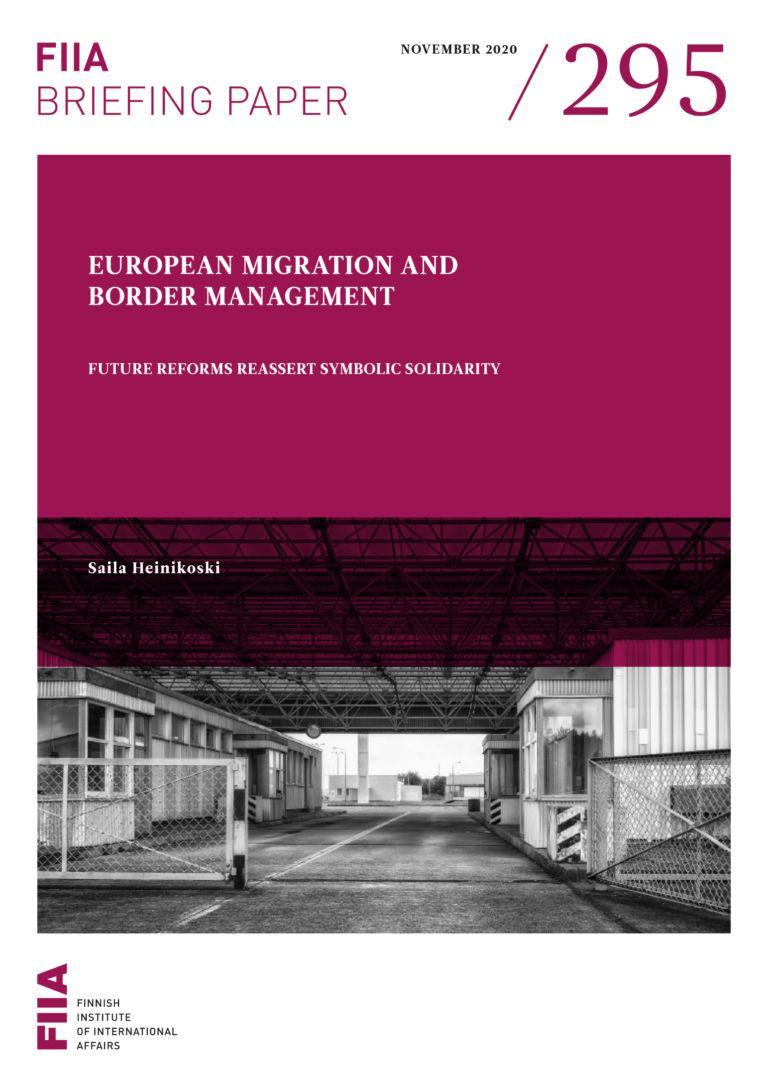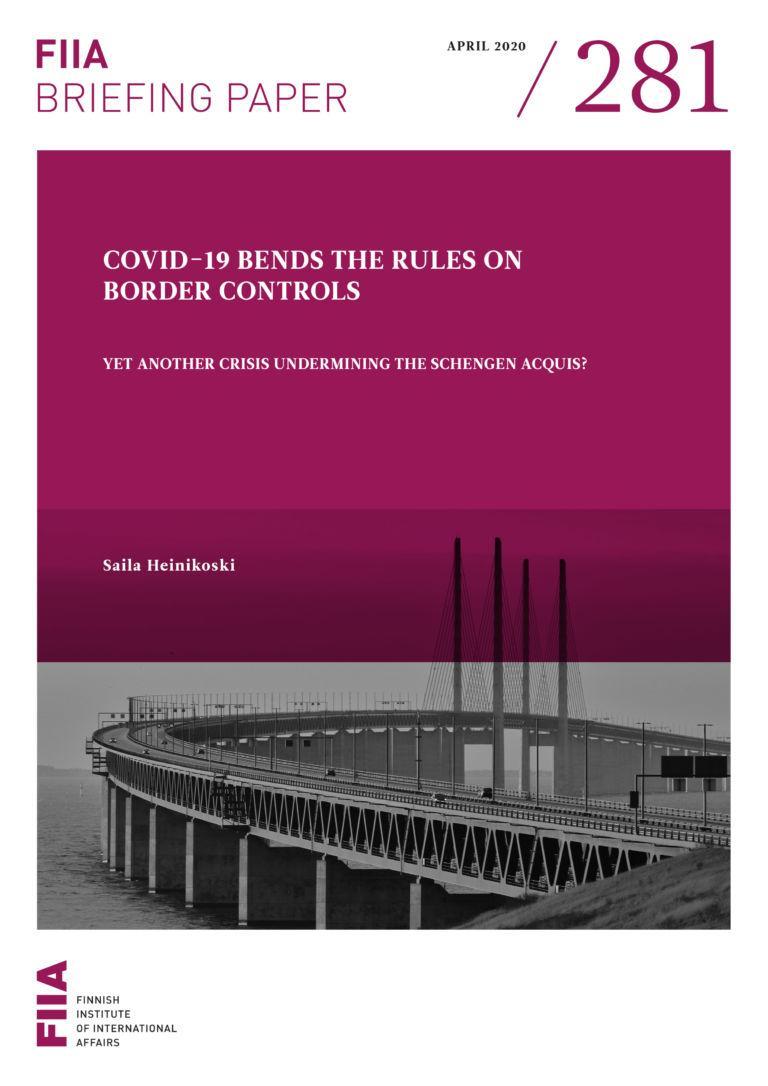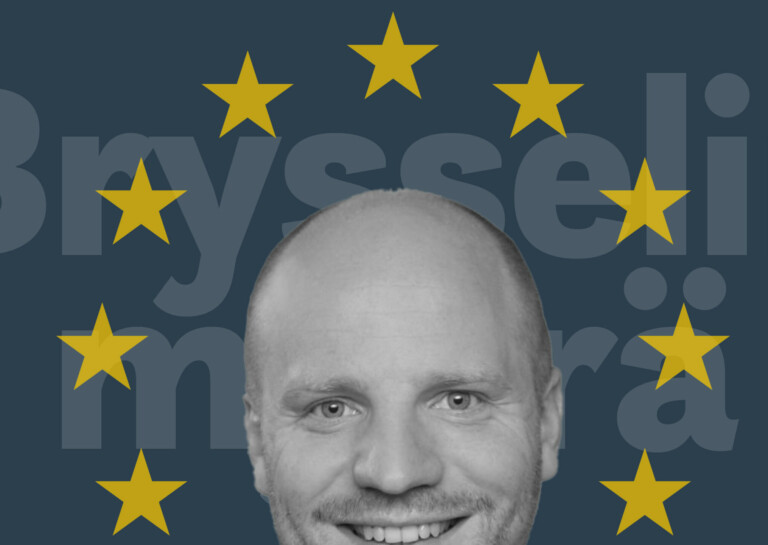Euroopan muuttoliike- ja rajapolitiikassa tapahtuu suuria symbolisia muutoksia vuonna 2021. Frontexin omat rajavartijat aloittavat työnsä tammikuussa ja muuttoliike- ja turvapaikkasopimus on määrä hyväksyä viimeistään kesäkuussa.
Euroopan komission syyskuussa 2020 antama ehdotus muuttoliike- ja turvapaikkasopimuksesta velvoittaisi jäsenvaltiot auttamaan toisiaan muuttoliikepaineessa, etsintä- ja pelastusoperaatioiden jälkeen sekä kriisitilanteissa.
”Pakollisesta yhteisvastuusta” huolimatta uusi sopimus ei luo yhteistä muuttoliikepolitiikkaa. Suuret jäsenvaltioiden väliset erot turvapaikan myöntämisessä säilyvät.
Vaikka Euroopassa ei ole vuoden 2015 jälkeen onnistuttu löytämään yhteistä ratkaisua muuttoliike- ja turvapaikkapolitiikkaan, jäsenvaltiot pääsivät nopeasti sopuun eurooppalaisesta raja- ja merivartioviraston asetuksesta 2019/1896. Asetuksen nojalla muun muassa palkataan Frontexin omat 10 000 rajavartijaa asteittain vuodesta 2021 alkaen.
Sekä muuttoliike- että rajahallintauudistukset ovat symbolisesti tärkeitä Euroopan integraatiolle. Jäsenvaltio päättää kuitenkin edelleen itse, kenellä on oikeus jäädä maahan ja kenen on palattava lähtömaahansa.
Introduction
Five years after the so-called refugee crisis, the European Union is finally discussing a permanent solution to responsibility-sharing in migration and asylum policies. The European Commission presented its proposal for a New Pact on Migration and Asylum in September 2020. Whereas the relocation of asylum-seekers and the sharing of responsibility has mainly relied on ad-hoc solutions and coalitions of the willing, a consensus has been easy to reach on the need to control the Union’s external borders and to cooperate with the countries of origin. This consensus has allowed the member states to agree on providing more resources for Frontex, despite the fact that some countries have been afraid that the deployment of Frontex border guards could constrain their national sovereignty. The regulation on the European Border and Coast Guard 2019/1896 granted Frontex more border guarding resources, including the creation of 10,000 European border guards progressively from 2021 onwards.
Migration, asylum and border control remain shared competences between the Union and the member states. Even if a common policy were declared in these matters, it would not mean conferring the decision-making power to the Union. Article 67(2) of the Treaty on the Functioning of the European Union states that the Union “shall frame a common policy on asylum, immigration and external border control, based on solidarity between Member States, which is fair towards third-country nationals”. The declared announcement of such a common policy would not necessarily lead to weakening national sovereignty. However, despite the power remaining in the hands of the member states, important symbolic steps are in the making. Examples of this include the new Frontex’s own border guards from 2021 onwards, and the solidarity mechanism of the Migration and Asylum Pact, in whatever form it eventually enters into force.
Shifting resources to Frontex indeed seems to be easier than agreeing on solidarity in migration and asylum affairs. The responsibilities of Frontex have been expanded several times since its establishment in 2004, the previous major regulation being approved only three years before the latest one. The reason for this ease may be political benefits for all countries, given that Frontex is considered to contribute to preventing third-country nationals from entering the Union. Ten thousand European border guards allow national leaders to bring home news that they are doing something to ease Europeans’ concerns; in the summer 2020 Eurobarometer survey, immigration was considered the third main concern facing the EU. However, responsibility-sharing in asylum and migration is politically much more sensitive.
In the following sections, these migration and border policies are discussed from the perspective of power dynamics and national sovereignty. The first section discusses the solidarity mechanism in the Commission-proposed New Pact on Asylum and Migration, particularly the two regulation proposals related to the solidarity mechanism in situations of migratory pressure and crisis.[1] The Pact has introduced what the Commission calls “mandatory solidarity” but maintains asylum and return decisions as a member-state responsibility. The Pact and the regulation proposals included in it are currently being processed in the EU legislative bodies, the Council and the European Parliament. The second section contrasts the migration debate with the recent European capacity-building in external border management, whereby the creation of European border troops appears symbolically important for common border management, although providing the necessary funding for the troops in the Multiannual Financial Framework (MFF) appears more difficult. The concluding section analyses what we can expect from future European border and migration policies.
New solidarity mechanism is symbolically important
The European Commission presented its New Pact on Asylum and Migration on 23 September 2020. It had already become evident in the aftermath of the so-called refugee crisis of 2015 that Hungary, Czechia and Poland would refuse to relocate asylum-seekers in their countries. Given that the countries did not comply with the previous mandatory relocation scheme, the Commission proposed the New Pact on Migration and Asylum, which includes the possibility to return sponsorship instead of relocation.
The proposed pact includes five regulation proposals related to migration management, crisis situations, biometric data collection, screening at the border and the procedure for international protection. In the first debate of the Home Affairs Ministers on 8 October, the German presidency was hopeful about reaching a political agreement before Christmas, although the Visegrad countries – Poland, Czechia, Hungary and Slovakia – were critical and were preparing their common approach.[2] Even if an agreement is reached within the Council, the interinstitutional negotiations between the Council and the European Parliament will be difficult. The Chair of the EP Committee on Civil Liberties, Justice and Home Affairs has already outlined that they would be pushing for mandatory relocation.[3]
The major political schism relates to the so-called solidarity mechanism included in Chapter 1 of the Commission’s regulation proposal on asylum and migration management (COM(2020) 610 final). In the event of migratory pressure or disembarkations following search and rescue operations, either a member state may request the launch or the Commission may judge that the solidarity mechanism should be activated. Article 45 of the proposal provides the possibility for four types of solidarity: relocation of asylum-seekers, return sponsorship, relocation of recent beneficiaries of international protection or, lastly, capacity-building measures in the field of asylum, reception, return, operational support and measures aimed at responding to migratory trends. Member states would be allowed to choose from the measures and indicate them to the Commission, which would adopt a legally binding instrument that outlines how the solidarity mechanism is implemented (implementing act).
If the voluntary contributions determined on the basis of population and GDP were to lead to a more than 30% shortfall in the number of required solidarity measures, the Commission could adjust the measures to meet the needs with another act. Even in this case, the member states could choose whether to provide 50% of their calculated share either through relocations or return sponsorship. In return sponsorship, the country would have to take care of the practicalities in returning a person subject to a return decision in the benefitting member state. However, if the person is not returned in eight months, they would be transferred to the territory of the country providing such return sponsorship. Although the countries have alternatives to choose from, it would eventually be up to the Commission to determine the number of people to be relocated and the countries that should adjust their share. This is a power which may face resistance from some member states.
The Pact also includes a separate regulation proposal addressing situations of crisis and force majeure in the field of migration and asylum (COM(2020) 613 final). It concerns situations where a mass influx of persons makes a member state’s asylum, reception or return system non-functional and can have serious consequences for the European asylum system, or where there is an imminent threat of such a situation. Again, the country could request the Commission to issue a decision to derogate from normal asylum procedures and time limits for a fixed period (implementing decision). A legally binding implementing act, in turn, would be needed for triggering the relocation or return sponsorship mechanism. In a crisis situation, other member states could only choose between relocating asylum-seekers or recent beneficiaries of international protection and return sponsorship.
For each relocated adult, the member states would be provided with EUR 10,000. For a minor, the sum would be EUR 12,000. Instead, if a country opted for return sponsorship, they would have to bear the practical and financial costs of the return of illegally remaining third-country nationals from the member state concerned. However, if the return was not successful within eight months, the returnees would be transferred to the sponsoring member state and the country would receive an equal sum for each transferred individual. This return sponsorship is obviously drafted in order to cater to the requirements of the few Eastern European countries that refuse to relocate people. Still, even the possibility of being obligated to receive people for whom return is not possible seems to be too much, judging by the preliminary reactions of some member states.
Although the Pact is intended to provide a fresh start with regard to migration, it should be noted that the main responsibility for processing applicants still rests with the countries of first entry. The Pact does not propose a European asylum and migration policy as such but provides more shared responsibility for processing asylum applications. Member states would continue to make their own decisions on providing asylum and granting international protection as well as on returns, while complying with current EU directives stipulating these fields. Other member states are assumed to respect these decisions, when international protection has already been granted or a return decision is issued. One could say that the Commission has created a package of proposals aimed at finding the lowest common denominator that would be possible for member states to accept from the perspective of domestic policy. Tough negotiations are likely to follow between the member states in the Council and between the Council and the European Parliament. The Commission, however, is hoping that the asylum and migration management regulation and the crisis regulation would be adopted by June 2021. The current German presidency, in turn, intends to reach a political agreement on major issues before the end of 2020.[4]
Asylum lottery maintained despite more responsibility-sharing
The pact was not intended to establish a common migration and asylum policy. However, in some instances, it has been considered a step in that direction. For example, a German presidency discussion paper ahead of the 13 November Justice and Home Affairs (JHA) Council provided that managed and orderly migration “sends a signal to the rest of the world that Europe has a strong common asylum and migration policy”.[5] In addition, Italian Prime Minister Giuseppe Conte tweeted that the “migration pact is an important step towards a really European migration policy”, but also called for certainty in returns and relocation.[6] In a similar vein, the Spanish Minister of the Interior, Fernando Grande-Marlaska, stated on the pact that “we clearly need a common European migration and asylum policy”.[7] His Finnish counterpart, Maria Ohisalo, also considered that the Schengen Area makes it “necessary to establish a common migration and asylum policy in the EU”.[8] Even though these accounts call for a common policy and want to send a signal of such, the pact does not include many tools to complement the existing harmonisation efforts on the conditions of asylum and migration policy.
The focus of the pact is on sharing responsibility for conducting asylum and return procedures, but it also includes measures that would contribute to harmonising procedural aspects. These aspects include time limits and the responsibility to apply an accelerated border procedure when less than 20% of the asylum applications made by the applicant’s co-nationals have been accepted Europe-wide. It could even be said that European migration and asylum policy is moving from mutual recognition to procedural harmonisation. The proposals would not seem to lead to substantive harmonisation, which refers to the actual decisions on who can stay and who must return. This still involves much variation between member states.
Despite the new pact and other ongoing attempts to harmonise recognition rates, member states remain the ones to define when they grant asylum or protection status to asylum-seekers. Differences in the recognition rates across EU member states continue to be significant, sometimes ranging for the same nationals from 93.8% (Afghan applicants in Italy) to 4.1% (Afghan applicants in Bulgaria) in 2019.[9] Even if asylum applications were more evenly shared across member states thanks to the new system, it would not resolve the problem of asylum being a lottery where one’s chances of protection depend on where the application is processed. Of more help in this regard might be the currently pending proposals on the Reception Conditions Directive harmonising appeal procedures and the Qualification Regulation replacing a previous directive on the criteria for protection. The Council and the Parliament have reached provisional political agreements on both proposals, but no progress has been made since early 2019. Some member states seem to be unhappy with the agreements and the parliament is reluctant to reopen the negotiations.[10] Although the Qualification Regulation would be a directly binding instrument unlike the current directive, which leaves the specific measures for member states to decide, it does seem unlikely that recognition criteria would become completely uniform. Nor is such a harmonisation objective stipulated in Article 78(2) of the Treaty on the Functioning of the European Union concerning the common European asylum system.
It is not yet known in what form the Migration Pact will eventually be adopted. Judging by previous legislative processes, it can be expected that the Commission’s power to launch the solidarity mechanism and determine its scope will spur debate in the Council in particular. Although the default option is that the mechanism is based on the measures chosen by member states themselves, the Commission would also be the body making a decision on the existence of a crisis situation and the required contributions. It can therefore happen that some countries play the sovereignty card in the negotiations over the new regulation. Even though a qualified majority is enough to pass the legislation, another question arises when the legislation is eventually passed: Will the solidarity mechanism function as agreed or will some countries refuse to do their share? The 2015 agreement on relocations was made with a qualified majority but failed to be implemented despite the fact that some countries’ refusal to relocate was later condemned as unlawful in the EU Court.
Overall, the Migration Pact was introduced as enforcing mandatory solidarity, which is symbolically important, but does not in principle obligate member states to receive anyone transferred from another country or to grant them asylum. It does represent a first attempt to create a truly functioning system of responsibility-sharing, but as such should not pose sovereignty concerns among member-state nationals. Migration and asylum policies remain in the hands of member states, but with the New Pact, the responsibility should no longer rest too heavily in the hands of a few states.
European border officers from 2021 onwards, but projected funding insufficient
Unlike the Migration Pact, the Frontex Regulation already entered into force on 4 December 2019 and the Frontex permanent corps will be operational progressively from early 2021. In contrast to years of inconclusive negotiations in migration and asylum matters, the legislative process shows the relative ease in accepting more resources for border management. However, accepting capacity-building on paper seems easier than providing the actual funds for it. The funds allocated for Frontex in the compromise agreement on the multiannual financial framework remain significantly smaller than the Commission envisaged in the regulation proposal establishing the standing corps.
The Frontex reform provides evidence that EU member states are finally doing something together at their external borders. The image of 10,000 officers, the first uniformed EU staff, is symbolically important and can be traced back to a wish expressed by the member states. In a European Council meeting on 28 June 2018, the states called for strengthening the supportive role of Frontex in the external border control and return policy “through increased resources and an enhanced mandate”.[11] The Commission provided its proposal on 12 September 2018, and Regulation 2019/1896 was already adopted in November 2019.
The standing corps consists of four categories of staff, which in 2021 will be composed of 1,000 statutory staff, 400 operational staff for long-term secondments, 3,600 for short-term secondments, and 1,500 reserve for rapid reaction. In order to reach 10,000 border guards at the latest by 2027, the statutory staff will increase to 4,000, long-term secondments to 1,500 and short-term deployments to 5,500. The reserve for the rapid reaction pool agreed in the previous Frontex Regulation 2016/1624 would not be included in the figure from 2025 onwards.
All member states except non-Schengen country Ireland will provide staff for Frontex in proportion to their population, including non-EU states Switzerland, Iceland and Norway, which are part of the Schengen Area. However, a problem with the realisation of the standing corps during the next seven years may arise with regard to the Frontex seven-year budget, currently envisaged as €5,148 million in total. According to calculations in the Commission proposal for the Frontex Regulation, the budget would barely cover the costs of the standing corps, let alone other costs of the agency.
All in all, the Regulation was adopted very quickly, only one year after the Commission proposal and without major disagreement. The Commission and Parliament proposed having more power in the decision-making of Frontex, but the member states kept the powers to themselves. In the end, only Spain and Italy voted against the Regulation in the Council. They considered it would decrease national resources to control their respective borders. Furthermore, the Italian government maintained that another part of the Regulation, having European border guards in the national territory without the permission of the state, could be considered a violation of national sovereignty.[12] Interestingly, this type of provision of assistance seemed to go against national sovereignty, whereas Spain and Italy have been actively promoting assistance from other states in asylum and migration policy, as discussed in the previous section. For European integration, it still appears symbolically significant to create the first European uniformed staff, but the impacts on state sovereignty seem to remain minor.
Where is the EU heading with its integration of migration and border management?
Migration and border management belong to core state powers, and the EU member states seem willing to decide for themselves which migrants they will allow to cross their borders or to remain in their country. The countries have approved the ability to intervene with European border guards in the event that all of the countries do not control their external borders effectively enough, a wish that the Frontex Regulation with its standing corps addresses. In the case of the Frontex Regulation, the only countries to vote against it were Italy and Spain, which along with Greece have been calling elsewhere for more solidarity in the processing of asylum applications. The Commission’s New Pact on Migration and Asylum could provide an answer to these concerns. At the same time, it remains to be seen how effectively the Frontex troops can be implemented if the funds allocated for Frontex do not increase in the interinstitutional negotiations on the next seven-year budget.
Although the negotiations on the Migration Pact are still in an early phase, the Visegrad countries have already expressed their reluctance towards the proposal to be obliged to either relocate people or to sponsor other member states in their return policy. It may also turn out that the Council wants to assume the power to decide on the details of the use of the solidarity mechanism from the Commission. Symbolically, after years of deadlock, it would be significant for the entire European integration process to be able to agree on a measure increasing solidarity in the migration and asylum policy. Approval of the pact could primarily help in improving the procedural harmonisation of asylum policy, but more equal recognition rates would also require EU institutions to reach a final agreement on the currently pending Qualification Regulation and Reception Conditions Directive, interinstitutional negotiations on which have not progressed since early 2019 due to differences of opinion in the Council. Migration, asylum and border policies remain one of the most sensitive areas of European integration, but they are issues where a common framework is necessary for the future of the Union and free movement within the Schengen Area.
Endnotes
[1] Proposal for a Regulation of the European Parliament and of the Council on asylum and migration management and amending Council Directive (EC) 2003/109 and the proposed Regulation (EU) XXX/XXX (Asylum and Migration Fund: https://eur-lex.europa.eu/legal-content/EN/TXT/?qid=1601291110635&uri=COM%3A2020%3A610%3AFIN) (COM(2020) 610 final) and Proposal for a Regulation of the European Parliament and of the Council addressing situations of crisis and force majeure in the field of migration and asylum (COM(2020) 613 final).
[2] Barigazzi, J. ‘Germany’s Horst Seehofer: Yes, we can get a political deal on migration’, Politico, 10 August 2020, https://www.politico.eu/article/german-interior-minister-we-can-succeed-in-reaching-a-first-deal-on-migration-asylum-migrants.
[3] Barigazzi, J. ‘Migration rubber hits political road’, Politico, 7 October 2020, https://www.politico.eu/article/eu-interior-ministers-migration-meeting-scrutiny.
[4] Council of the European Union (2020), Video conference of ministers of home affairs, 8 October 2020, https://www.consilium.europa.eu/en/meetings/jha/2020/10/08/.
[5] German Presidency (2020), A new way forward on European migration and asylum policy - Presidency discussion paper. Brussels, 28 October 2020, 12272/20.
[6] See https://twitter.com/GiuseppeConteIT/status/1308757360803033088.
[7] Spanish Government (2020), Grande-Marlaska defiende ante sus homólogos de la UE la necesidad de articular una verdadera cooperación con los países de origen y tránsito de la migración, https://www.lamoncloa.gob.es/serviciosdeprensa/notasprensa/interior/Paginas/2020/08102020_migraciones.aspx.
[8] Finnish Ministry of the Interior (2020), EU home affairs ministers discuss the reform of migration and asylum policy at their informal meeting, https://valtioneuvosto.fi/en/-/1410869/eu-home-affairs-ministers-discuss-the-reform-of-migration-and-asylum-policy-at-their-informal-meeting.
[9] European Council on Refugees and Exiles (2020), Asylum statistics in Europe: Factsheet, https://www.ecre.org//data/wordpress/htdocs/wp-content/uploads/2020/06/Statistics-Briefing-ECRE.pdf.
[10] Council of the European Union (2019), Reform of the Common European Asylum System and Resettlement. Progress report. 6600/19, https://data.consilium.europa.eu/doc/document/ST-6600-2019-INIT/en/pdf.
[11] European Council meeting (28 June 2018) – Conclusions, https://www.consilium.europa.eu/media/35936/28-euco-final-conclusions-en.pdf.
[12] Senato italiano (2019), Nota n. 27, La riforma della Guardia di frontiera e costiera europea, 15 April 2019, http://www.senato.it/service/PDF/PDFServer/BGT/01107553.pdf.






